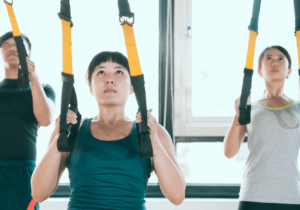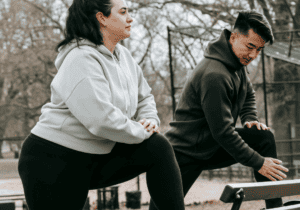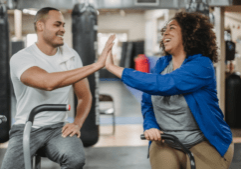Fitness is for Everyone: Adjust Lower Body Exercises to YOUR Body
Accessible Fitness Part 2
In the first article of this series, I talked about how you’re allowed to change your workouts to fit your body plus a few tactics to help you do that. In this article, I’m giving you specific modifications for common lower body exercises. Creating a sustainable workout plan is all about finding the movements that feel best for YOUR body!
The lower body exercises in your program might be more complex, but they all essentially boil down to two motions: a squat (hips and knees are bending) or a hinge (hips bend a lot but knees only bend a little). If you’re not sure what to substitute for a movement in your program, take a look at what your knees and hips are doing to help you decide.
There are multiple ways to modify each of the main movements. I recommend trying all of them and even combining some variations to figure out which feels best for you. Some are slight variations, and some involve substituting a completely different exercise that achieves the same goals. If you come across a different lower body exercise in your program and you’re not sure how to modify it, comment below and ask!
Lower Body Exercises - Variations and Modifications
Squats
Squat Depth is a huge buzzword, but the truth is: only go down as far as the squat still feels good and you can keep the same form. You can range from a shallow squat to a deep squat depending on what feels most comfortable to you. (see range of motion in part 1)
The Squat Stance looks a little different on everyone, because everyone’s bodies are different. Use different foot positions to see what feels best. Try a narrower stance, then a wider one. A very wide stance is called a sumo squat. Try pointing your feet straight forward, then try different degrees of turning them out to see what feels best for your ankles, knees, and hips.
Wall or Ball Squat
Doing this can help take some weight off of your feet and knees.
Option 1: put your back against a smooth wall and slide up and down.
Option 2: put an exercise ball in between your back and the wall to facilitate easier sliding. Keep your back straight as you go up and down.
Box Squat
Squatting with a chair, stool, or box behind you can be very helpful for having a consistent place to stop as well as a place to sit down if your legs get tired. The chair or object you have behind you can be as high or as low as you prefer.
Zercher Squat
A zercher squat has you hold the weight in your elbows instead of your hands. Although traditionally done with a barbell, this variation can be used with any weight. It takes the pressure off your hands when squatting with weight, but still allows you to get the full-body benefits of a front squat.
Adding weight to your squat
If you want to add weight to your squat but either have trouble holding weights or have no weights at home, try using a backpack on the front or back of your body. You can fill it with the desired weight, then put it on to do a weighted squat. This can take away the strain of holding weights in your hands and allow you to adjust the weight in small increments.
Lunges
I like to think of lunges as a one-sided squat, so in many ways, you can refer to the squat variations above and apply them to lunges. Lunges take more knee and ankle stability than squats because they’re unilateral (one-sided). If you don’t feel comfortable doing lunges or any of these variations, substitute with the squat variations above.
If you like doing lunges but feel unstable doing them, hold onto a chair, wall, or other object (such as a staff or TRX strap) during the exercise.
Static Lunge and/or Split Squat
Find a split stance position that’s comfortable for you, then lower yourself down and back up. Keep your weight centered over both legs and lowering, or try to put more weight on your forward leg with the back leg acting as a kickstand. Your feet don’t move during these to help with stability, and just like any other variation, the depth is up to you.
Reverse Lunge
If you like lunges but a forward lunge doesn’t feel good to your joints, try a reverse lunge. Instead of one leg going forward, it goes backward.
Step Up
For a one-legged movement that’s not a lunge, try a step up! Start at whatever step height feels best to you, and increase over time when you feel comfortable.
Deadlifts
Elevate the weight on a chair or bench for a higher start to your deadlift.
Good Morning/Hip Hinge
Do not use weights for good mornings. Only hinge back as far as you can without changing your form. (see: range of motion in part 1)
Romanian Deadlift
Instead of picking the weight up from the ground, start from the top and hinge down until you feel your hamstrings stop you.
Glute Bridge
Lay on the ground with your knees up, then push your hips up while keeping a neutral spine. This has the same hinging motion as a deadlift but can relieve strain on your back. Depending on your comfort level with this movement, you can add weight or do them with a single leg variation.
Hip Thrust
Put your shoulders and your feet on benches or chairs, then push your hips up while keeping a neutral spine. If you feel comfortable with this, you can add weight to the crease of your hips.
Lateral Lunges and/or Cossack Squats
Side Stepping
Do this with your legs slightly bent to engage similar muscles as a lateral lunge. Add a band around your ankles or thighs to make it more challenging.
Lateral Step Up
This gives you a lot of the same feeling as a lateral lunge or single-leg squat. You can experiment with the height of the step and your distance from the step.
If you have questions about any of these variations on lower body exercises, ask below! In part 3 of this series, I’ll be talking about variations for upper body movements.
Sarah Siertle, a strength and movement coach, specializes in introducing people to strength training and works to make the fitness world a more inclusive place. She has been a movement instructor since 2012 and also teaches swing dance around the US. Find other articles written by Sarah on her coach profile. Let Sarah help you get STRONG so you can take advantage of life’s adventures!







